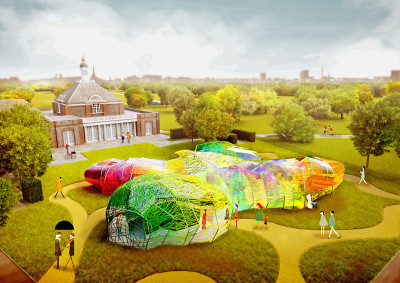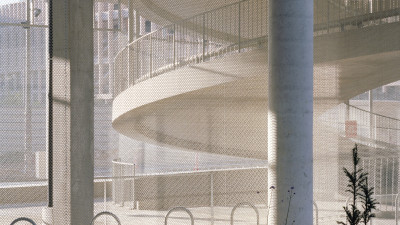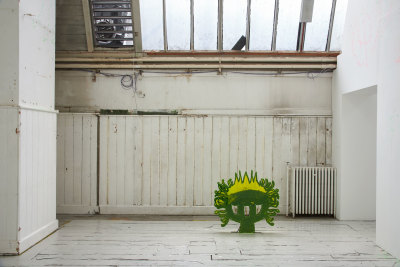The month in architecture
The month in architecture
Everything you need to know that happened in March
By Helena Cuss
Published 31 March 2015
The biggest architecture news, the latest prizes and the wackiest new projects – rounded up into one handy post each month.
-
1. The death of Frei Otto
Following the death of Frei Otto on 9 March, it was announced that the German architect is to be awarded this year’s Pritzker Prize. He is most famous for designing the tented roof of the 1972 Olympic Stadium in Munich.Upon hearing news of his Pritzker Prize shortly before his death, Frei said: “My architectural drive was to design new types of buildings to help poor people, especially following natural disasters and catastrophes. So what shall be better for me than to win this prize? I will use whatever time is left to me to keep doing what I have been doing.”
The American architect Michael Graves also died this month, on 12 March. He was a leading Postmodernist most famous for the Portland Building.
Frei’s obituary in the Guardian
Graves’s obituary in Architectural Review
Pritzker Prize website2. Horace Walpole’s Strawberry Hill House reopens
After a decade of work, Strawberry Hill House in Twickenham has reopened to the public. Known for its turrets and battlements in their famous “wedding cake” cladding, this Gothic castle was built by Horace Walpole, son of the first Prime Minister, in 1747. It can rightly be called the birthplace of the Gothic tradition and everything which came after, right up to the black haired, body-pierced school children of our time: Walpole was inspired to write The Castle of Otranto, the first Gothic novel, after dreaming that he’d seen a giant iron fist on the staircase.3. Petition to save Robin Hood Gardens
The Twentieth Century Society has revived a campaign to save the Robin Hoof Gardens estate in Poplar, East London. A prime example of Brutalist architecture, it was built in 1972 by the Smithsons and is due for demolition as part of a larger housing project. The original preservation campaign was backed by high-profile architects such as Richard Rogers, Zaha Hadid, and Robert Venturi, but in 2009 the estate was refused heritage status and legally made immune from getting a listed building status.Twentieth Century Society website
4. Shortlist announced for Nine Elms Thames bridge
A competition to design a new Thames Bridge was launched by Wandsworth Council in December 2014, and this month the final four were announced, including RA architect Michael Hopkins.The shortlisted teams are: Ove Arup & Partner Ltd with Hopkins Architects and Grant Associates; Buro Happold with Marks Barfield Architects and J&L Gibbons Landscape Architects; Bystrup with Robin Snell and Partners; and Arup with Amanda Levete Architects.
It is part of a wider £1 billion project to regenerate Nine Elms, which includes the controversial redevelopment of Battersea Power Station into luxury flats.
5. New tower for Westminster Abbey
Westminster Abbey this month won planning permission to build its first new tower in 300 years. It will create public access to a museum of treasures and curiosities in the church’s mysterious attic galleries – to be renamed the Queen’s Diamond Jubilee Galleries – which are currently only accessed by staff and a few scholars a year.Designed by Ptolemy Dean, the abbey’s Surveyor of Fabric, the tower will sit inconspicuously between a 16th century chapel and 13th century chapter house, and is expected to be finished in 2018.
6. Skyscraper planned for the Swiss Alps
The American architectural practice Morphosis, led by the Pritzker Prize-winner Thom Payne, has revealed designs for a 381m high hotel skyscraper in Vals. The design is a vision of slender glass-clad minimalism, intended to mirror the surrounding landscape while simultaneously blending in with it. It will have one room per floor, which will offer the guest stunning panoramic views of the Alps. The building is due for completion in 2019.7. Serpentine Pavilion 2015 unveiled
The Spanish architects, SelgasCano, last week revealed their plans for this summer’s Serpentine Pavilion: a “chrysalis-like” structure made up of a shell of opaque and transparent fluorine-plastic fabric in different colours. The plastic should filter daylight like stained glass, creating interior spaces with coloured light, whilst in the evenings it will be lit from within, becoming a luminous multi-coloured structure. The pavilion opens on 25 June and closes on 18 October.8. Ikea launches Better Shelter flat packed refugee homes
You’ve probably made a sofa or a bookshelf from Ikea, or maybe you just go for the meatballs. But this month Ikea launched something which could be truly life-changing: 10,000 flat-pack temporary shelters for refugees left homeless by conflict and natural disasters.Developed with the help of 40 refugee families in Iraq and Ethiopia, the shelters are made of lightweight polymer panels laminated with thermal insulation, which clip onto a steel frame. They are expected to last for three years and are twice as large as traditional refuge tents, housing up to five people.
They will be distributed globally by the United Nations Refugee Agency and it is hoped that they will begin issuing them this summer.
-

Serpentine Pavilion designed by SelgasCano 2015

Hall at Strawberry Hill

Assembly of Better Shelter prototype

Frei Otto's roof at the Munich Olympic Park, 1972







